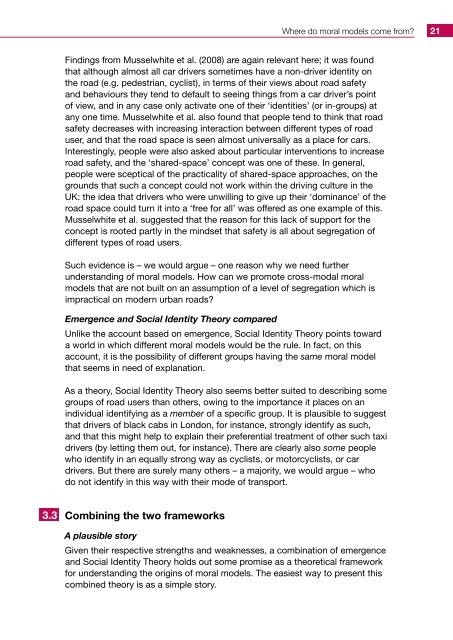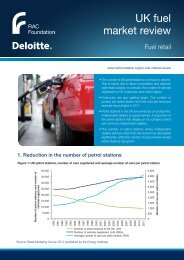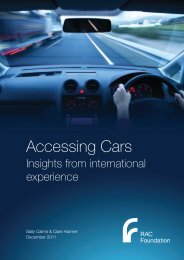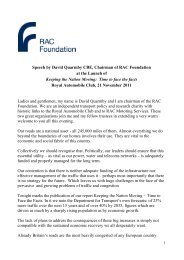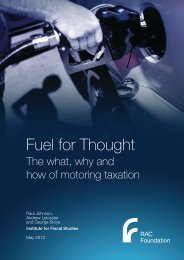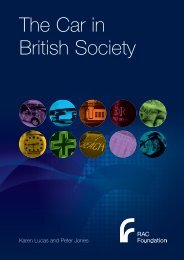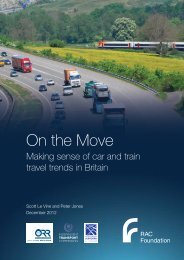Road sharing - does it matter what road users think of each other?
Road sharing - does it matter what road users think of each other?
Road sharing - does it matter what road users think of each other?
Create successful ePaper yourself
Turn your PDF publications into a flip-book with our unique Google optimized e-Paper software.
Where do moral models come from?21Findings from Musselwh<strong>it</strong>e et al. (2008) are again relevant here; <strong>it</strong> was foundthat although almost all car drivers sometimes have a non-driver ident<strong>it</strong>y onthe <strong>road</strong> (e.g. pedestrian, cyclist), in terms <strong>of</strong> their views about <strong>road</strong> safetyand behaviours they tend to default to seeing things from a car driver’s point<strong>of</strong> view, and in any case only activate one <strong>of</strong> their ‘ident<strong>it</strong>ies’ (or in-groups) atany one time. Musselwh<strong>it</strong>e et al. also found that people tend to <strong>think</strong> that <strong>road</strong>safety decreases w<strong>it</strong>h increasing interaction between different types <strong>of</strong> <strong>road</strong>user, and that the <strong>road</strong> space is seen almost universally as a place for cars.Interestingly, people were also asked about particular interventions to increase<strong>road</strong> safety, and the ‘shared-space’ concept was one <strong>of</strong> these. In general,people were sceptical <strong>of</strong> the practical<strong>it</strong>y <strong>of</strong> shared-space approaches, on thegrounds that such a concept could not work w<strong>it</strong>hin the driving culture in theUK: the idea that drivers who were unwilling to give up their ‘dominance’ <strong>of</strong> the<strong>road</strong> space could turn <strong>it</strong> into a ‘free for all’ was <strong>of</strong>fered as one example <strong>of</strong> this.Musselwh<strong>it</strong>e et al. suggested that the reason for this lack <strong>of</strong> support for theconcept is rooted partly in the mindset that safety is all about segregation <strong>of</strong>different types <strong>of</strong> <strong>road</strong> <strong>users</strong>.Such evidence is – we would argue – one reason why we need furtherunderstanding <strong>of</strong> moral models. How can we promote cross-modal moralmodels that are not built on an assumption <strong>of</strong> a level <strong>of</strong> segregation which isimpractical on modern urban <strong>road</strong>s?Emergence and Social Ident<strong>it</strong>y Theory comparedUnlike the account based on emergence, Social Ident<strong>it</strong>y Theory points towarda world in which different moral models would be the rule. In fact, on thisaccount, <strong>it</strong> is the possibil<strong>it</strong>y <strong>of</strong> different groups having the same moral modelthat seems in need <strong>of</strong> explanation.As a theory, Social Ident<strong>it</strong>y Theory also seems better su<strong>it</strong>ed to describing somegroups <strong>of</strong> <strong>road</strong> <strong>users</strong> than <strong>other</strong>s, owing to the importance <strong>it</strong> places on anindividual identifying as a member <strong>of</strong> a specific group. It is plausible to suggestthat drivers <strong>of</strong> black cabs in London, for instance, strongly identify as such,and that this might help to explain their preferential treatment <strong>of</strong> <strong>other</strong> such taxidrivers (by letting them out, for instance). There are clearly also some peoplewho identify in an equally strong way as cyclists, or motorcyclists, or cardrivers. But there are surely many <strong>other</strong>s – a major<strong>it</strong>y, we would argue – whodo not identify in this way w<strong>it</strong>h their mode <strong>of</strong> transport.3.3Combining the two frameworksA plausible storyGiven their respective strengths and weaknesses, a combination <strong>of</strong> emergenceand Social Ident<strong>it</strong>y Theory holds out some promise as a theoretical frameworkfor understanding the origins <strong>of</strong> moral models. The easiest way to present thiscombined theory is as a simple story.


